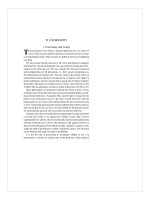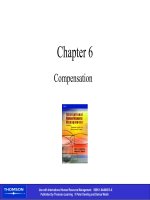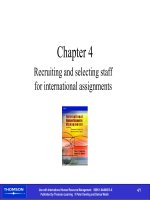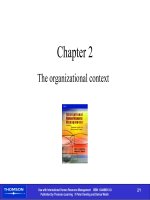International human resource management - Chapter 6 ppt
Bạn đang xem bản rút gọn của tài liệu. Xem và tải ngay bản đầy đủ của tài liệu tại đây (385.3 KB, 55 trang )
Use with International Human Resource Management ISBN 1-84480013-X
Published by Thomson Learning © Peter Dowling and Denice Welch
Chapter 6
Compensation
Use with International Human Resource Management ISBN 1-84480013-X
Published by Thomson Learning © Peter Dowling and Denice Welch
Chapter objectives
In the introductory chapter we described IHR managers as
grappling with complex issues. International managers must
(1) manage more activities from a broader perspective, (2) be
more involved in the lives of their far-flung employees, (3)
balance the needs of PCNs, HCNs and TCNs, (4) control
exposure to financial and political risks and (5) be
increasingly aware of and responsive to host-country and
regional influences. All of these issues and concerns are
brought out in a discussion of compensation issues. In this
chapter we:
(cont.)
Use with International Human Resource Management ISBN 1-84480013-X
Published by Thomson Learning © Peter Dowling and Denice Welch
Chapter objectives (cont.)
•
Examine the complexities that arise when firms move from compensation at the domestic level to
compensation in an International context.
•
Detail the key components of an international compensation program.
•
Outline the two main approaches to international compensation and the advantages and disadvantages of
each approach.
•
Examine the special problem areas of taxation, valid international living cost data and the problem of
managing TCN compensation.
•
Examine the recent developments and global compensation issues.
Use with International Human Resource Management ISBN 1-84480013-X
Published by Thomson Learning © Peter Dowling and Denice Welch
Introduction
•
Global compensation managers (that is, everyone involved
at any level in pay-related decisions) increasingly deal with
two areas of focus. They must manage highly complex and
turbulent local details while concurrently building and
maintaining a unified, strategic pattern of compensation
policies, practices and values.
(cont.)
Use with International Human Resource Management ISBN 1-84480013-X
Published by Thomson Learning © Peter Dowling and Denice Welch
Introduction (cont.)
•
For multinationals successfully to manage compensation
and benefits requires knowledge of employment and
taxation law, customs, environment and employment
practices of many foreign countries, familiarity with
currency fluctuations and the effect of inflation on
compensation and an understanding of why and when
special allowances must be supplied and which allowances
are necessary in what countries – all within the context of
shifting political, economic and social conditions.
Use with International Human Resource Management ISBN 1-84480013-X
Published by Thomson Learning © Peter Dowling and Denice Welch
Objectives of international
compensation
•
When developing international compensation policies, a
firm seeks to satisfy several objectives. First, the policy
should be consistent with the overall strategy, structure and
business needs of the multinational.
•
Second, the policy must work to attract and retain staff in
the areas where the multinational has the greatest needs
and opportunities. Hence the policy must be competitive
and recognize factors such as incentive for foreign service,
tax equalization and reimbursement for reasonable costs.
(cont.)
Use with International Human Resource Management ISBN 1-84480013-X
Published by Thomson Learning © Peter Dowling and Denice Welch
Objectives of international
compensation (cont.)
•
Third, the policy should facilitate the transfer of
international employees in the most cost-effective manner
for the firm. Fourth, the policy must give due consideration
to equity and ease of administration.
•
The international employee will also have a number of
objectives that need to be achieved from the firm’s
compensation policy. First, the employee will expect the
policy to offer financial protection in terms of benefits,
social security and living costs in the foreign location.
(cont.)
Use with International Human Resource Management ISBN 1-84480013-X
Published by Thomson Learning © Peter Dowling and Denice Welch
Objectives of international
compensation (cont.)
•
Second, the employee will expect a foreign assignment to
offer opportunities for financial advancement through
income and/or savings.
•
Third, the employee will expect issues such as housing,
education of children and recreation to be addressed in the
policy. (The employee will also have expectations in terms
of career advancement and repatriation, as discussed in
Chapters 3, 5 and 7.)
(cont.)
Use with International Human Resource Management ISBN 1-84480013-X
Published by Thomson Learning © Peter Dowling and Denice Welch
Objectives of international
compensation (cont.)
•
If we contrast the objectives of the multinational and the
employee, we see, of course, the potential for many
complexities and possible problems, as some of these
objectives cannot be maximized on both sides.
•
Firms must rethink the traditional view that local
conditions dominate international compensation strategy.
Use with International Human Resource Management ISBN 1-84480013-X
Published by Thomson Learning © Peter Dowling and Denice Welch
Key components of an international
compensation program
The area of international compensation is complex primarily
because multinationals must cater to three categories of
employees: PCNs, TCNs and HCNs.
Key components of international compensation are as
follows:
(cont.)
Use with International Human Resource Management ISBN 1-84480013-X
Published by Thomson Learning © Peter Dowling and Denice Welch
Key components of an international
compensation program (cont.)
•
Base salary
–
In a domestic context, base salary denotes the amount of cash
compensation serving as a benchmark for other compensation elements
(such as bonuses and benefits).
–
For expatriates, it is the primary component of a package of allowances,
many of which are directly related to base salary (e.g. foreign service
premium, cost-of-living allowance, housing allowance) and also the basis
for in-service benefits and pension contributions. It may be paid in home or
local-country currency.
–
The base salary is the foundation block for international compensation
whether the employee is a PCN or TCN. Major differences can occur in the
employee’s package depending on whether the base salary is linked to the
home country of the PCN or TCN, or whether an international rate is paid.
Use with International Human Resource Management ISBN 1-84480013-X
Published by Thomson Learning © Peter Dowling and Denice Welch
Key components of an international
compensation program (cont.)
•
Foreign service inducement/hardship premium
–
Parent-country nationals often receive a salary premium as an inducement to
accept a foreign assignment or as compensation for any hardship caused by the
transfer.
•
The definition of hardship, eligibility for the premium and amount and timing of
payment must be addressed.
•
In cases in which hardship is determined, US firms often refer to the US Department
of State’s Hardship Post Differentials Guidelines to determine an appropriate level of
payment.
–
Making international comparisons of the cost of living is problematic.
–
These payments are more commonly paid to PCNs than TCNs. Foreign service
inducements, if used, are usually made in the form of a percentage of salary,
usually 5–40 per cent of base pay.
•
Such payments vary, depending upon the assignment, actual hardship, tax
consequences and length of assignment.
Use with International Human Resource Management ISBN 1-84480013-X
Published by Thomson Learning © Peter Dowling and Denice Welch
Key components of an international
compensation program (cont.)
•
Allowances
–
Issues concerning allowances can be very challenging to a firm establishing
an overall compensation policy, partly because of the various forms of
allowances that exist.
–
The cost-of-living allowance (COLA), which typically receives the most
attention, involves a payment to compensate for differences in expenditures
between the home country and the foreign country (to account for inflation
differentials, for example).
–
The COLA may also include payments for housing and utilities, personal
income tax or discretionary items.
–
The provision of a housing allowance implies that employees should be
entitled to maintain their home-country living standards (or, in some cases,
receive accommodation that is equivalent to that provided for similar
foreign employees and peers).
Use with International Human Resource Management ISBN 1-84480013-X
Published by Thomson Learning © Peter Dowling and Denice Welch
Key components of an international
compensation program (cont.)
•
Allowances (cont.)
•
Other alternatives include company-provided housing, either mandatory or
optional, a fixed housing allowance or assessment of a portion of income, out
of which actual housing costs are paid.
–
As a firm internationalizes, formal policies become more necessary and
efficient.
–
There is also a provision for home leave allowances.
•
Many employers cover the expense of one or more trips back to the home
country each year.
–
Firms allowing use of home leave allowances for foreign travel need to be
aware that expatriate employees with limited international experience who
opt for foreign travel rather than returning home may become more
homesick than other expatriates who return home for a ‘reality check’ with
fellow employees and friends.
Use with International Human Resource Management ISBN 1-84480013-X
Published by Thomson Learning © Peter Dowling and Denice Welch
Key components of an international
compensation program (cont.)
•
Allowances (cont.)
–
Education allowances for expatriates’ children are also an integral part of
any international compensation policy.
•
Allowances for education can cover items such as tuition, language class tuition,
enrolment fees, books and supplies, transportation, room and board and uniforms.
•
PCNs and TCNs usually receive the same treatment concerning educational
expenses.
–
Relocation allowances usually cover moving, shipping and storage charges,
temporary living expenses, subsidies regarding appliance or car purchases
(or sales) and down payments or lease-related charges.
•
Allowances regarding perquisites (cars, club memberships, servants10 and so on)
may also need to be considered (usually for more senior positions, but this varies
according to location).
•
These allowances are often contingent upon tax-equalization policies and
practices in both the home and the host countries.
Use with International Human Resource Management ISBN 1-84480013-X
Published by Thomson Learning © Peter Dowling and Denice Welch
Key components of an international
compensation program (cont.)
•
Allowances (cont.)
–
Spouse assistance to help guard against or offset income lost by an
expatriate’s spouse as a result of relocating abroad.
•
Although some firms may pay an allowance to make up for a spouse’s lost
income, US firms are beginning to focus on providing spouses with employment
opportunities abroad, either by offering job-search assistance or employment in
the firm’s foreign office (subject to a work visa being available).
–
Multinationals generally pay allowances in order to encourage employees to
take international assignments and to keep employees ‘whole’ relative to
home standards.
•
In terms of housing, companies usually pay a tax-equalized housing allowance in
order to discourage the purchase of housing and/or to compensate for higher
housing costs.
•
This allowance is adjusted periodically based on estimates of both local and
foreign housing costs.
Use with International Human Resource Management ISBN 1-84480013-X
Published by Thomson Learning © Peter Dowling and Denice Welch
Key components of an international
compensation program (cont.)
•
Benefits
–
The complexity inherent in international benefits often brings more
difficulties than when dealing with compensation.
–
Pension plans are very difficult to deal with country-to-country, as national
practices vary considerably.
•
Transportability of pension plans, medical coverage and social security benefits
are very difficult to normalize.
–
Firms need to address many issues when considering benefits, including:
•
Whether or not to maintain expatriates in home-country programs, particularly if the firm
does not receive a tax deduction for it.
•
Whether firms have the option of enrolling expatriates in host-country benefit programs
and/or making up any difference in coverage.
•
Whether expatriates should receive home-country or host-country social security benefits.
Use with International Human Resource Management ISBN 1-84480013-X
Published by Thomson Learning © Peter Dowling and Denice Welch
Key components of an international
compensation program (cont.)
•
Benefits (cont.)
–
In some countries, expatriates cannot opt out of local social security
programs. In such circumstances, the firm normally pays for these additional
costs.
•
European PCNs and TCNs enjoy portable social security benefits within the
European Union.
–
Laws governing private benefit practices differ from country to country, and
firm practices also vary.
–
Multinationals have generally done a good job of planning for the retirement
needs of their PCN employees, but this is generally less the case for TCNs.
•
TCNs may have little or no home-country social security coverage;
•
They may have spent many years in countries that do not permit currency
transfers of accrued benefit payments;
•
Or they may spend their final year or two of employment in a country where
final average salary is in a currency that relates unfavorably to their home-
country currency.
Use with International Human Resource Management ISBN 1-84480013-X
Published by Thomson Learning © Peter Dowling and Denice Welch
Key components of an international
compensation program (cont.)
•
Benefits (cont.)
–
In addition to the already discussed benefits, multinationals also provide
vacations and special leave.
–
Included as part of the employee’s regular vacation, annual home leave
usually provides airfares for families to return to their home countries.
–
Rest and rehabilitation leave, based on the conditions of the host country,
also provides the employee’s family with free airfares to a more
comfortable location near the host country.
–
Emergency provisions are available in case of a death or illness in the
family.
–
Employees in hardship locations often receive additional leave expense
payments and rest and rehabilitation periods.
Use with International Human Resource Management ISBN 1-84480013-X
Published by Thomson Learning © Peter Dowling and Denice Welch
Approaches to international
compensation
There are two main options in the area of international compensation – the
Going Rate Approach (also referred to as the Market Rate Approach) and the
Balance Sheet Approach (sometimes known as the Build-up Approach).
•
The Going Rate Approach
Table 6-1: Going Rate Approach
Use with International Human Resource Management ISBN 1-84480013-X
Published by Thomson Learning © Peter Dowling and Denice Welch
Approaches to international
compensation (cont.)
•
The Going Rate Approach (cont.)
–
With this approach, the base salary for international transfer is linked to the
salary structure in the host country. The multinational usually obtains
information from local compensation surveys and must decide whether
local nationals (HCNs), expatriates of the same nationality or expatriates of
all nationalities will be the reference point in terms of benchmarking.
•
For example, a Japanese bank operating in New York would need to decide
whether its reference point would be local US salaries, other Japanese
competitors in New York or all foreign banks operating in New York.
–
With the Going Rate Approach, if the location is in a low-pay county, the
multinational usually supplements base pay with additional benefits and
payments.
Use with International Human Resource Management ISBN 1-84480013-X
Published by Thomson Learning © Peter Dowling and Denice Welch
Approaches to international
compensation (cont.)
•
The Going Rate Approach (cont.)
–
Advantages and disadvantages of the Going Rate Approach
Table 6-2: Advantages and disadvantages of the
Going Rate Approach
Use with International Human Resource Management ISBN 1-84480013-X
Published by Thomson Learning © Peter Dowling and Denice Welch
Approaches to international
compensation (cont.)
•
The Balance Sheet Approach
–
The basic objective is to ‘keep the expatriate whole’ (that is, maintaining
relativity to PCN colleagues and compensating for the costs of an
international assignment) through maintenance of home-country living
standard plus a financial inducement to make the package attractive.
Table 6-3: The Balance Sheet Approach
Use with International Human Resource Management ISBN 1-84480013-X
Published by Thomson Learning © Peter Dowling and Denice Welch
Approaches to international
compensation (cont.)
•
The Balance Sheet Approach (cont.)
–
The approach links the base salary for PCNs and TCNs to the salary
structure of the relevant home country.
•
For example, a US executive taking up an international position would have his
or her compensation package built upon the US base-salary level rather than
that applicable to the host country.
–
The key assumption of this approach is that foreign assignees should not
suffer a material loss due to their transfer, and this is accomplished through
the utilization of what is generally referred to as the Balance-sheet
Approach.
Use with International Human Resource Management ISBN 1-84480013-X
Published by Thomson Learning © Peter Dowling and Denice Welch
Approaches to international
compensation (cont.)
•
The Balance Sheet Approach (cont.)
–
There are four major categories of outlays incurred by expatriates that are
incorporated in the Balance Sheet Approach:
•
Goods and services – home-country outlays for items such as food, personal
care, clothing, household furnishings, recreation, transportation, and medical
care.
•
Housing – the major costs associated with housing in the host country.
•
Income taxes – parent-country and host-country income taxes.
•
Reserve – contributions to savings, payments for benefits, pension
contributions, investments, education expenses, social security taxes, etc.









